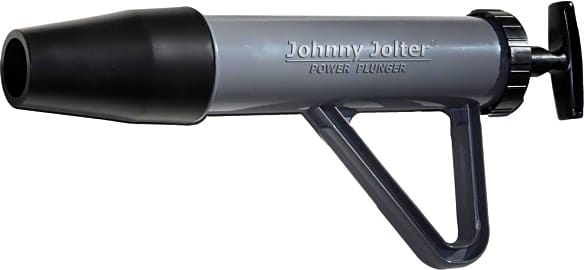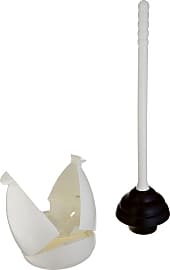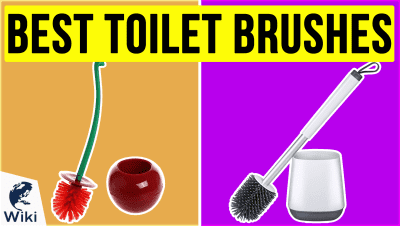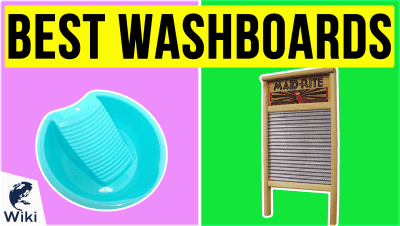The 10 Best Plungers

This wiki has been updated 42 times since it was first published in August of 2015. It may not be the most glamorous or hands-off solution to your bathroom problems, but before you consider spending money on an expensive visit from a plumber, why not try one of these economical and effective plungers? They can clear all kinds of stubborn blockages in toilets and other drains, and are always good to have at your disposal in case of something unexpected. When users buy our independently chosen editorial recommendations, we may earn commissions to help fund the Wiki.
Editor's Notes
May 12, 2020:
When it comes to low-tech household supplies, no tool is more essential than the plunger. You probably already know what these manually operated devices are good for, but for the uninitiated: plungers usually consist of a suction cup head attached to an elongated handle, and their purpose is to dislodge toilet blockages (and thereby avert disaster, really). The models we've chosen are made from a variety of materials including plastic, stainless steel, rubber, and more. Some come with caddies that make storage simple and mess-free, while others feature heavy-duty builds that make them ideal for inclusion in the professional plumber's toolkit.
With regard to updates, the Quickie Lysol and Mr. Clean Turbo are new additions to the list, chosen for their intuitive designs and effectiveness at removing particularly stubborn blockages. In fact, the latter model now occupies the top spot in the list. To complete your bathroom set, and to ensure your toilet remains both clog-free and sparkling-clean, consider pairing your plunger with a matching toilet brush.
Special Honors
Blue Donuts Free Standing If your bathroom decor is of the sleek, modern variety, this plunger will fit right in. It's made from stainless steel with an understated brushed finish. It measures 18 inches in height, and there are ventilation holes in the caddy that help curb mold growth. wayfair.com
Clorox Splash Guard Everyone knows that vigorous plunging can result in a messy bathroom. Luckily, this option is cleverly designed to keep splashes contained in the bowl. It's sized for compatibility with most toilets, and it has an appealing contemporary shape. target.com
Alumiluxe Rust-Proof Featuring a caddy with an incorporated lid, this device will elevate the look of your bathroom, which is a lot more than can be said about most plungers. It comes in three stylish colors and is made from corrosion-resistant metal. It is on the pricier end of the spectrum, however. bedbathandbeyond.com
A Brief History Of (And Some Surprising Uses For) the Plunger
Plungers have even been used to save lives, as on at least 3 different occasions in the 1980s, emergency crews used a plunger to perform CPR.
If you've ever needed to use the plunger at a friend's house or in the middle of a crowded party, then you know the ice-cold feeling of panic that accompanies it. Now imagine needing to use the plunger, only to realize it hadn't been invented yet.
That was the unfortunate reality for the first 50 years or so of modern indoor plumbing. No one is absolutely certain when the plunger was invented, but we do know that the first ones required an S-trap drainage pipe to work, and those only came along in the 1850s. It's believed that the modern plunger wouldn't hit the scene until later in the 19th century, when rubber became more widely available.
While the tools immediately became a necessity for anyone with indoor plumbing (and the first one was probably sold to someone in a very big hurry), it wasn't long before people started finding other uses for them. Jazz cats used them to mute their trombones and trumpets, with members of Duke Ellington's band popularizing the practice in the 1920s. Hopefully they at least rinsed them off first.
Plungers have even been used to save lives, as on at least 3 different occasions in the 1980s, emergency crews used a plunger to perform CPR. They proved so effective, in fact, that a company in Minnesota has been attempting to patent a plunger-like resuscitation device.
Also, in Oklahoma in 2012, a woman actually fended off burglars by using her plunger to knock the guns out of their hands. Talk about fighting dirty.
Tips For Using Your Plunger Effectively
If you're shopping for a plunger, chances are you're not doing so to fend off armed robbers or re-start Grandpa's heart. However, not everyone who uses a plunger for its more basic purpose knows how to do so effectively.
The first thing you need to do is pick the right tool for the job. There are two basic plunger types: cups and flanges. If you're needing to unclog a sink or bathtub, then a cup plunger (the one that's flat all the way around) is what you want. However, if the toilet is overflowing, then you'll need a flange plunger (the one that has an extra bit of rubber jutting out in the middle) to do the job.
If you're getting nowhere despite your best efforts, it may be time to move on to an auger, or to break down and call a professional.
The reason for this relates to exactly how they work. Plungers increase the amount of atmospheric pressure on the clog, forcing it back and forth until ultimately it's dislodged. That's why it's so important to get a tight seal — and that's why the type of plunger matters. Flange plungers use that center piece — the flange — to fit over the hole in your toilet, giving you a much tighter seal. Using a traditional plunger can still work, but it's much less effective. Likewise, the flange would just get in the way when used on a sink or tub.
This also hints at the proper way to use them. Most people just put all of their effort into pushing down, ignoring the latter half of the motion. However, since you'll want to put constant pressure on the clog, you should pull up with an equal amount of force as you push down. Repeat the motion five or six times, being sure to keep a tight seal.
If you see bubbles popping up alongside the rubber, then you don't have it on there properly. Reposition the plunger and try again.
Once the water in the bowl empties, you should flush it again to make sure everything is moving smoothly. If it clogs up, shut the water off and get back to work. If you're getting nowhere despite your best efforts, it may be time to move on to an auger, or to break down and call a professional.
Tips For Keeping Drains Clear
No matter how much of a plunger samurai you may consider yourself, no one wants to be in a situation where using one is necessary. It's vastly preferable to prevent clogs from ever happening in the first place.
One important thing to be aware of is what not to put down the drain. Don't pour grease or coffee grounds down your kitchen sink, and install a hair trap in your bathtub. Likewise, limit the amount of toilet paper you use, or flush as you go to prevent any build-up. You could also consider using a bidet to side-step the issue entirely.
Don't pour grease or coffee grounds down your kitchen sink, and install a hair trap in your bathtub.
Also, if you live in a home with small children, make sure they don't try to flush anything they shouldn't, like action figures or the cat. The cat will likely be able to teach them their lesson just fine, but the action figure can prove costly if you have to call a plumber to exhume him from his watery grave.
You can also clean out your pipes with hot water, and maybe even a pipe brush if you're feeling especially industrious. Vinegar is excellent for cleaning pipe walls, as all you need to do is pour some down the drain and let it sit for 30 minutes or so before rinsing it out with hot water.
Most store-bought drain cleaners are very harsh on your pipes, but if you must use one, be sure to follow the directions. Don't use more than is absolutely necessary, and set an alarm so that you remember to rinse it out. However, some cleaners (like lye) can be very effective at clearing out soap scum and hair. You can also get natural cleaners that use bacteria to eat away at organic waste.
If you treat your pipes well, they're much less likely to betray you at an inopportune time. If you're hard on them, however, I can guarantee they'll wait until your boss comes over for dinner to get their revenge.















